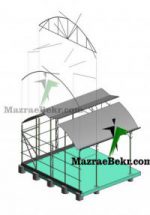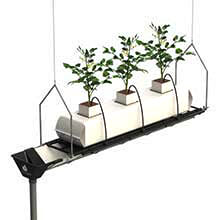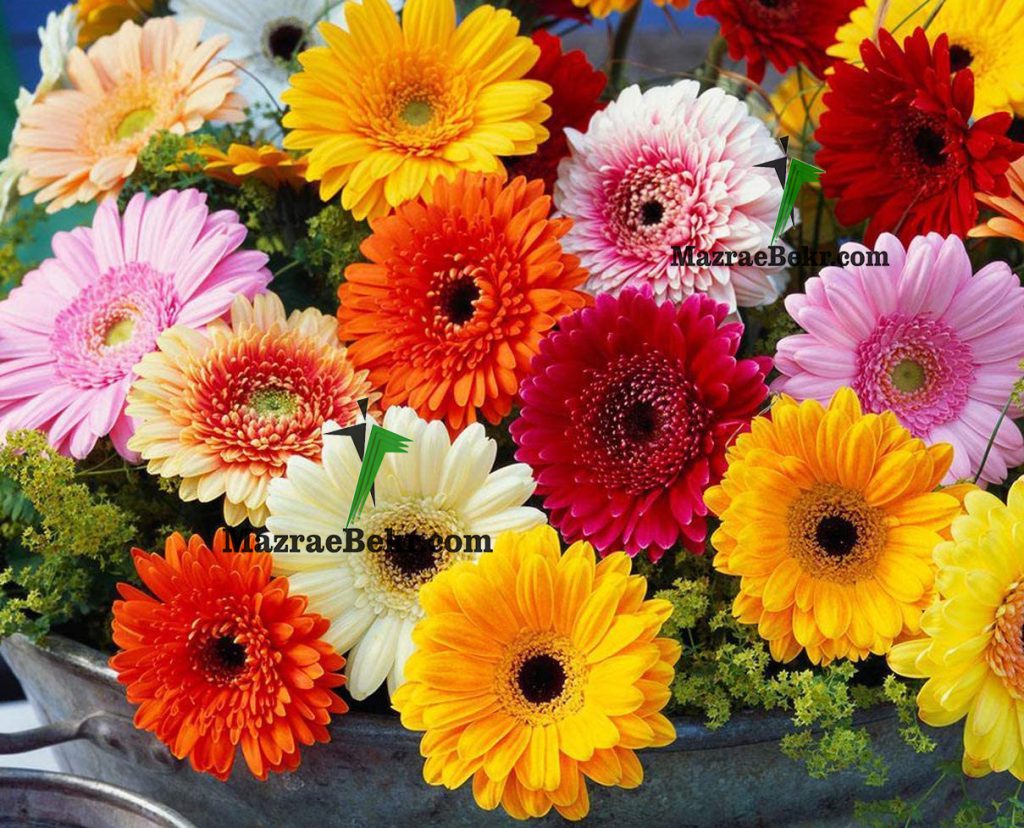Cultivation of Gerber Jamesonia
Cut flowers production is one of the most important agricultural industries in developed countries. Due to the diversity of humans, the desire to produce flowers with a high color variation is of interest to producers. Gerbera plant is one of the flowers that has a variety of species in flower color. In the researches of this plant, it also tries to produce higher quality flowers of color and flowers, long flowering period, flowering in low light seasons, production of flowers with more stem resistance and longer flower life after harvest. Gerbera has about 40 species, about 30 of which are native to tropical Asia, and of them, 13 belong to southern Africa. Currently, Gerbera is grown in 25 countries, about 12001100 heckling is greenhouse. 50% of the area under the Germra ship is in the world, in the Netherlands andItaly.
Botany
Gerbera is a perennical herbaceous plant with deep and cold-sensitive roots belonging to the astrace family (sunflower). This plant does not have stems and leaves grow without stems and near the soil surface. Its leaves are 15 to 45 cm long and their upper surface is dark green and the underlying surface is pale green. The leaves are divided into several sections with deep crevices and their surface is covered with soft fluffs. The total height of the plant is 45 cm and occupies about 60 cm of space. Flower diametersin wild speciesare 7-10 cm and in greenhouse types the flowers are coarser and have a diameter of 15-25 cm.
Gerbera has compound inflorescess. The end of the flowering stem is grown as a shroud and is formed according to the flower on it. The central flowers are tubes that have the role of male organs and pollen production, and the flowers on the margins have the role of female organs. Flowers consist of beautiful radial petals in yellow, pink, orange, red, purple, white and cream. The diameter of the flowers is 12-5 cm and the length of the stem reaches about 25-60 cm. The lifespan of cut flowers of this plant is 7-8days.
Gerbera flowers are divided according to different characteristics such as size and diameter of flowers, petal color, flower center color, number of rows of petals and shape of petals. Based on plant height, this plant is divided into two categories of pots with a height of 25-30 cm and a cut branch that has a height of 30 cm and more. The majority of Gerbera species are produced from hybridization between Gerbera jamesonii and other South African species of Gerbera viridifolia, through which cultivars vary in size and shape and are mostly suitable commercial sites for greenhouse cultivation.
Cultivation of Gerbera flowers
In order to cultivate gerbera flower optimally, environmental needs of this plant must be identified and produced according to the desired environmentconditions.
In soil culture system, the plant needs a bed depth of 45-60 cm with light texture, good drainage and 1-3% organic matter. In hydroponic culture, the substrate mixture consists of two parts: peat moss, one vermicollite, one part antiseptic loamy soil, one part coarse sand or perlite, whose acidity is between 5-6. Also, the combination of 20-30% perlight and 70-80% peat is an affordable and suitable treatment for hydroponic plant. In soil substrates on both stacks, two rows of plants with distances of 30-40 cm are cultivated that if we consider the distance of plants to be 20-25 cm, we will have an average of 6-8 plants per square meter. In case of increased crop density, less light reaches the plants and the stems become narrow, weak and herbaceous. In hydroponic cultivation, the plant needs a meter volume from the substrate because the nutrient solution is directly available to the plant, for example, if each plant in the soil plant needs 25 liters of substrate volume, this amount reaches to 4 liters in hydroponiccultivation.
pH is suitable for germra cultivation 7-6.5.
Carbon dioxide: Increasing carbon dioxide in gerbera breeding greenhouse has a positive effect on plant yield, especially when light intensity is high, because carbon dioxide is one of the most important factors for the production of the main sugar material of the plant. It is necessary to absorb all other environmental factors, especially light and temperature, to be high enough so that as long as these factors are not high enough, the increase in carbon dioxide does not increase the quality and production.
The amount of CO2 is added to the greenhouse environment by perforated pipes for the transmission of gas or additional materials after burning gas or oil, when we use organic matter (animal manure) CO2 will be released naturally.
Light: Flowering of this plant is not dependent on day length, but it requires a lot of light for proper growth and flowering.
High light intensity in gerbera breeding increases photosynthesis, carbohydrate storage and increases the life of cut flowers. Low light intensity causes elongation of stems and delay in tightening and insufficient strength of stem causes damping. This plant needs a bright place with about 16 hours of light and in high light intensity, flowering is better, but for the production of flowers with long tails, semi-sun conditions and a little shade, this plant is sensitive to the light (phototrophism) and bends to the light, so in flowering it should be closed to the stem of the wire flower, which in addition to the strength of the flower stem, prevents it became its light .
Temperature: In the cultivation of this plant, the number of leaves, the growth of lateral stems, the development of flower buds and consequently the amount of crop is affected by the ambient temperature, this plant is sensitive to cold and the minimum temperature for it is 5 degrees Celsius, so it has been observed in cold areas in the greenhouse that plants produce more flowers when the difference between air temperature and soil is low. It’s a way of not. Also, in winter and autumn, flower quality in cool greenhouse is better than hot greenhouse. For this plant, the daily temperature of 21 and 17 degrees Celsius until the observation of flower buds is optimal, then the daily temperature of 24 degrees accelerates the development of the bud, the temperature increases the leaf area and the highest leaf surface is observed at 25 degrees, with increasing the difference in night and day temperature (Dif),the length of thetailings increases.
Irrigation: In modern greenhouses, gerbera breeding uses two types of irrigation systems, sprinkler irrigation system in the early stages of root growth and development and drip irrigation system is used for the rest of the growth stages, in drip irrigation, the amount of water for each germra plant during the day should not be less than 500 ml, as well as every 3-4 weeks in order to wash the environment around the roots should be less than 500 ml. Pure water was used to wash the root environment. Gerbera requires high water requirements and of course a suitable drainage bed. Of course, excessive irrigation leads to crown rot and plant infection with powder mold and buttritis, and salinity of irrigation water accelerates aging, reduces flower shelf life, reduces flower diameter and shortens the damping.
Humidity: Suitable relative humidity is 85-60% and high humidity in the greenhouse causes the lifting and killing of flower stems and in cold weather, low light in winter increases the prevalence of fungal diseases, as well as low humidity in the greenhouse, closes the apertures, reduces co2absorption, reduces photosynthesis and decreases flowering and decreases the quality offlowers.
Nutrition: Iron and magnesium deficiency are common in soil cultivation of this flower, which is mostly used in sand, so in addition to using 150 ppm nitrogen, 60 ppm phosphorus and 60 ppm potassium for each plant in soil cultivation, liquid fertilizers should also be used during the growing season. In hydroponic cultivation, the amounts of elements in each fertilizer application required for mature plants in winter were: 150 ppm nitrogen, 150-180 ppm potassium, 25-35 ppm phosphorus, 10-150 ppm Calcium 0 ppm, 30-40 ppm magnesium, 50-40 ppm sulfur, 1.5 ppm iron and 0.75 ppm magnesium, which in summer due to the increase in plant growth, to the above numbers. 25-40% will be added.
In the case of Gerbera plant, it is better to use nitrogen as nitrate because the use of ammonium in winter and low temperature causes leaf elongation and inefficiency ofplants.
Duplication and graspe
Germra propagation is done by seed planting at 13-18 °C in autumn and early spring. It is also possible to reproduce this plant by dividing the plant in early spring or preparing cuttings in summer. In seed enhancement, plants are not uniform and in most of them, flowers are closed at night and this is not a good trait for germra cut flowers, soseed breeding is not common today, non-heterosexual germra increase is done by plant division methods, cuttings, micro-seedlings, and microprocessors. the most common method of proliferation for the increase of gerbera is microdiazadi.
In the past, this plant was reproduced by dividing plants and seeds, which due to the slowness and difficulty of this method, today, the increase in glass is used to rapidly increase the specific and selected culties.
In pruning of this plant, the lower leaves of the plant, which is older, are separated from the plant to prevent rot and spreadpests.
flower illness
Stem fractures occur when the plant is allowed to wilt during the day or when the day temperature rises rapidly in sunny conditions. Maintaining soil moisture when the day is warm or reducing the air temperature can minimize the fracture before harvesting thestem.
Wilting occurs before flowering puberty, when the branch is still attached to the plant and just when it is fully developed. This problem is most likely due to a lack of carbohydrates necessary to achieve rapid flower development. This often occurs after a period of cloudy days with low light intensity after a sunny day. If possible, cultivars resistant to this complication should be sigged andcultivated.
Flower Harvesting
The flower harvesting stage is very sensitive and must be harvested before the indoor flowers are pollened and indeed when the pollen grains of the outer row of flowers are seen. The flower should be picked from the plant. Because by cutting the stem, part of it remains on the plant and begins to rot, and this decayed part can infect the brain of the plant and stop the growth or rotting of new shoots. After picking, it is necessary to cut 2 to 4 cm from the end of their stem skewed, this section consists of very narrow wooden vessels through which water is hardly transferred into the stem due to the possibility of entering the air bubble into the wooden vessel at the time of harvest, by cutting the lower part of the stem, the air bubbles are removed, which causes more absorption of water in the middle of the stem. It can be important in preventing cleavage and bending the neck of flowers. After harvesting at 40°C, flowers can be stored for 7-8 days.
Packaging
The stems should be placed in water for 6 to 24 hours before packing and absorb enough water. If a large portion of the stem(10-15 cm is suitable) is placed in water, it will absorb more water, during which timeit should provide a cool temperature(2-4 °C), a germra flower preservative solution including silver nitrate (20-30 mg/L) + sucrose(3-6%), silver nitrate (120mg/L). g) + sukrose(2%) + nickel chloride (150 mg).
Gerbera stems tend to bend a lot and since the bent stems do not have much commercial value, the height of the stems should be less than 40 cm and firm and straight and their size should not be less than 7 cm, which usually closes the flowers to racquet-shaped cardboard plates and prevents the bending of the fragile stems of this flower.
Export
In terms of economic importance of germra flower production through tissue culture, it is at the top of research priorities of ornamental plants in Iran. Currently, most gerbera plants are imported to Iran from Dutch companies such as Preesman, Schrurs, Terranigra, florist, which is one of the biggest obstacles to the development of flower production industry in Iran. It is possible to use advanced plant development techniques such as tissue culture by supporting the production and development of new and marketable cultivars and has taken an effective step towards increasing the production of ornamental plants and their exports. Be. Considering the suitability of Iran’s climatic conditions for the production and export of this flower, as well as the importance of this flower in the world market, which is the fifth largest cut flower in the world in terms of production and sales, and also because it has beauty, variety of colors, yield, long life after harvest and high harvest frequency, is one of the suitable choices for greenhouse production in Iran.









